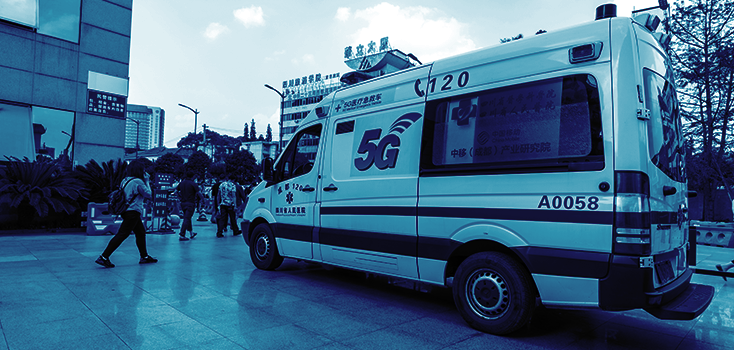
5G brings the hospital to the patient
Thanks to digitization and 5G, the idea of ambulance as a mobile, networked hospital that comes to the patient can become a reality.
Stroke is the leading cause of permanent disability in Austria and the third leading cause of death. The sooner a corresponding therapy – a medical dissolution of the vascular occlusion or an operative reopening of the affected vessel – is applied, the more efficient it is. Through telemedicine valuable time can be gained. The first, delicate approaches in this are already being used in the Salzburg Rescue Service in a pilot project with the Christian Doppler Clinic. If a stroke is suspected, the patient’s parameters are sent to the hospital in advance. The hospital can better prepare for acute cases and, if necessary, schedule surgery and staff at an early stage.
Rescue services are currently in transition – and telemedicine is the keyword here. According to
Klaus Markstaller, head of the Department of Anesthetics, General Intensive Care Medicine and Pain Therapy at MedUni Vienna, 50% of the emergency medical operations would not have taken place.
Thanks to digitization and the 5G network, the idea of an ambulance as a mobile, networked hospital that comes to the patient can become reality. Emergency paramedics of the highest qualification – so-called paramedics – are then connected on site by means of video streaming with doctors, for example in the hospital or the operations center. You get delegated via the Internet medical instructions. A scenario that could be expanded with augmented reality and the use of smart glasses. Data and information can be exchanged synchronously in real time between the actors involved in patient care. The transmission speed and low latency of 5G meet the requirements of telemedicine.
The basis for emergency medicine of the future is data. By mobile ultrasound devices, for example, in an accident without delay internal bleeding could be detected in order to set appropriate blockages. For patients with possible head trauma or stroke, portable CT scanners are invaluable. The telenot doctor is virtually involved in the assignment and can use the data to give a much better medical assessment. Thus, the ambulance becomes a high-quality emergency room. But not only a technical upgrade is necessary. Telemedicine also requires increased training needs, both for the paramedics and the doctors.
According to information from the Vienna Hospital Association (KAV), telemedicine development is currently under development. In the German city of Aachen it is already on. The telenot doctor has been working there for five years. In over 12,000 cases, he was already connected via video to the site. The telenot doctor receives the basic vital signs of the patients – blood pressure, heartbeat or whatever medication they take – to make a first diagnosis and to be able to guide the paramedics. On average, the use of the telenot doctor takes 18 minutes. On the other hand, if the ambulance comes with the emergency vehicle, the average time is 53 minutes. And time is a deciding factor for good emergency care. In addition, more emergencies could be supported by an ambulance, not insignificant in times of medical malpractice. With 5G, the Aachen model can reach a new dimension.
Of course, telemedicine is not limited to the rescue service. It can also help in nursing homes where there is no medical care around the clock. Telemedicine could prevent the residents from being unnecessarily hospitalized and treated at home.
References:
Websites
https://www.a1.net/BusinessChange/pd/5g_notfallmedizin_v2/ (retrieved on 14.9.19)

